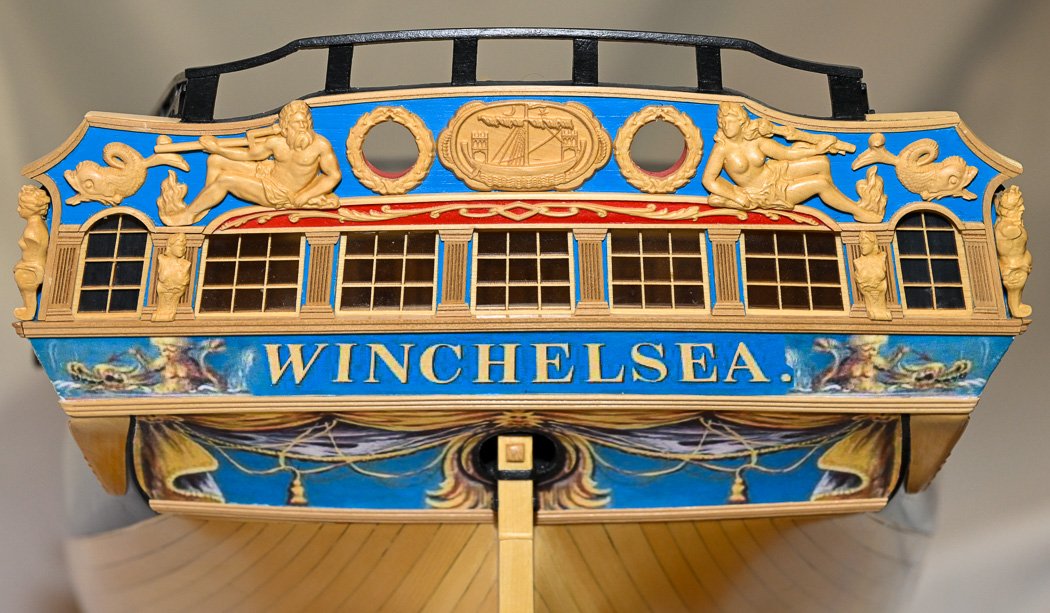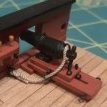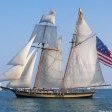MORE HANDBOOKS ARE ON THEIR WAY! We will let you know when they get here.
×
-
Posts
4,077 -
Joined
-
Last visited
Reputation Activity
-
 glbarlow reacted to DelF in HMS Speedy by Delf - FINISHED - Vanguard Models - Scale 1:64 - Master Shipwright edition
glbarlow reacted to DelF in HMS Speedy by Delf - FINISHED - Vanguard Models - Scale 1:64 - Master Shipwright edition
Thanks everyone, for the kind comments and likes. SpyGlass - I didn't see your post until I did my second one on techniques, where you'll see great minds think alike!
-
 glbarlow reacted to VTHokiEE in HMS Speedy by Delf - FINISHED - Vanguard Models - Scale 1:64 - Master Shipwright edition
glbarlow reacted to VTHokiEE in HMS Speedy by Delf - FINISHED - Vanguard Models - Scale 1:64 - Master Shipwright edition
This is awesome and really timely for me as I'm quickly approaching my guns. Thank you for all the details!
-
 glbarlow reacted to VTHokiEE in HMS Speedy by Delf - FINISHED - Vanguard Models - Scale 1:64 - Master Shipwright edition
glbarlow reacted to VTHokiEE in HMS Speedy by Delf - FINISHED - Vanguard Models - Scale 1:64 - Master Shipwright edition
You sent me off on a hunt hopefully I can find some Black and Brown varieties in the states. The fun of determining if a random fly fishing website will actually deliver on the sale 😀
-
 glbarlow reacted to DelF in HMS Speedy by Delf - FINISHED - Vanguard Models - Scale 1:64 - Master Shipwright edition
glbarlow reacted to DelF in HMS Speedy by Delf - FINISHED - Vanguard Models - Scale 1:64 - Master Shipwright edition
Apart from the fact that it doesn't earn you a clip round the ear from an irate spouse?
It's just so fine Glenn. If you're seizing 0.10 mm line with 0.10 mm line it looks clunky to my eye. The fly tying stuff is just 0.04 mm - less than 2 thou in imperial. It's so thin it adds virtually no thickness to the rope you're seizing - hopefully you could see that in some of my recent shots? Fly tying thread comes in various types and diameters. 18/0 is the thinnest I've found - you may find it described as 30D (Denier). I don't know if my brand - Semperfli - is available in the States but if not a fisherman's supplier should be able to advise on an alternative.
Or you could just continue with clunky seizings and sore ears 😁. And thank you for the very kind comments, by the way.
Derek
-
 glbarlow got a reaction from Saburo in HM Cutter Cheerful 1806 by glbarlow - FINISHED - 1:48
glbarlow got a reaction from Saburo in HM Cutter Cheerful 1806 by glbarlow - FINISHED - 1:48
Hey Garthog,
In the past I sorted guessed by where the plank stopped lying flush with the one above it, that’s still true but I’d often guess wrong by a few millimeters either way which led to an inconsistent curve, I was always catching up on subsequent planks.
Lining the hull takes out the guess work. The tick marks showed bulkhead 6 is a full width plank but from bulkhead 5 to the bow the tick marks showed sequentially less than full width, hence the taper start point. That may change on the second, lower belt of 10 rows, another good reason for the two belts, but it was true of the top eight.
I also found by starting the taper at the same point, bh 6, I kept a nice curve. Not sure if that’s true for every model, but it is for Cheerful, the tick parks supported that.
I am not perfect on my cuts. Every other plank I recheck the distance (in mm) from the last plank to the bottom tick park, my original tape mark for row 8, and divide by the number of remaining planks. Just me validating the tick marks, the measuring is more precise than just the pencil mark, a little perfectionist overkill probably. It doesn’t change the width of the plank at the bow much but it does some, it’s better to adjust as I go than to have a very wide or skinny plank 8. I really like this method. It’s tedious to do all the prep but it pays off.
Hope that helps.
-
 glbarlow got a reaction from Ronald-V in Chris Watton and Vanguard Models news and updates
glbarlow got a reaction from Ronald-V in Chris Watton and Vanguard Models news and updates
Dang it, now I have to buy another Vanguard model. 😂🤣
-
 glbarlow got a reaction from BenD in Chris Watton and Vanguard Models news and updates
glbarlow got a reaction from BenD in Chris Watton and Vanguard Models news and updates
Dang it, now I have to buy another Vanguard model. 😂🤣
-
 glbarlow reacted to chris watton in Chris Watton and Vanguard Models news and updates
glbarlow reacted to chris watton in Chris Watton and Vanguard Models news and updates
Cheers again, very helpful posts. I shall probably go with a 20 gun and work up, as this make most sense.
I have to be honest and say I have never bothered to see what other companies are doing, I have never cared one jot, as I have always preferred to do what I think is right/what I like, rather than reacting to what others are doing.
Having said that, Initially, Atalanta was on the cards, as I bought the plans for that - but I now realise the everyone and their mother are now doing a Swan class, so I feel a 20 gun small frigate from the same period is a very good substitute.
Out of all the kits I have designed in the past, there are only two I would very much like to revisit and give them the treatment/designs they so deserve, a brig and a small ship of the line, which I did two decades ago.
Lou, I keep looking at my Bristol designs, and may carry on with them, but knowing what I know now, I need more slightly smaller kits before purchasing the large amount of materials needed for such a large kit. When I started Bristol, the plan was to use standard materials (basswood), and use my Italian sub contractor to laser cut the parts - but this has changed as I realised quickly that the standards/quality of cutting were not what I had envisaged.
The upside to this is that it forced me to purchase my own laser machine, and a lot more freedom to design how I like without worrying about the costs of paying someone for the time, and wondering if all the parts I paid for will fit as I want them to.
One more thing I would like to add, not a single part of my new kits are an 'afterthought', I try to give each and every part the attention they need, so that they fit with the 'whole'
-
 glbarlow reacted to Vane in Chris Watton and Vanguard Models news and updates
glbarlow reacted to Vane in Chris Watton and Vanguard Models news and updates
I am very excited to see the progress and new models coming up. Once i have finilized some of my current builds (including the Speedy) I am looking for a new Vanguard ship to take on.
In my view, when it comes to the next models, I would argue that it should simply be a business decision for getting Vanguard models to grow and not so much about individual opinions here. Design a model that fits and expand the line up you have. Also think about what kits your competitors already have on the market and do something unique. Finally, always keep in mind your brand. Stick with the certain style that you want Vanguards to be rather than just developing randomly projects that has nothing in common.
My 50 Cent
-
 glbarlow got a reaction from DelF in HMS Speedy by Delf - FINISHED - Vanguard Models - Scale 1:64 - Master Shipwright edition
glbarlow got a reaction from DelF in HMS Speedy by Delf - FINISHED - Vanguard Models - Scale 1:64 - Master Shipwright edition
Whoops, crossed posts. I have added this to my reference folder.
Any reason for fly fishing thread vs the common thread I steal from my wife?
Great and informative posts. I’ve rigged lots of cannons, but this puts steps in a new light with clever techniques.
-
 glbarlow got a reaction from DelF in HMS Speedy by Delf - FINISHED - Vanguard Models - Scale 1:64 - Master Shipwright edition
glbarlow got a reaction from DelF in HMS Speedy by Delf - FINISHED - Vanguard Models - Scale 1:64 - Master Shipwright edition
Truly excellent and the reference model for the rest of us. This is where I’ll come to see how to do mine.
-
 glbarlow reacted to DelF in HMS Speedy by Delf - FINISHED - Vanguard Models - Scale 1:64 - Master Shipwright edition
glbarlow reacted to DelF in HMS Speedy by Delf - FINISHED - Vanguard Models - Scale 1:64 - Master Shipwright edition
Gun rigging - the process
As promised, here are a few notes on how I went about rigging the guns. None of these techniques are original, but if nothing else it'll remind me what to do for the starboard battery! The material I used was as follows:
Blocks - 2mm single blocks from Vanguard Models. Superb quality. Larger guns would have a single and a double block for each tackle; two singles are acceptable for these tiddlers
Breeching - I ran up a 0.75mm rope on my Syren Rope Rocket, using 3 strands of DMC 20 Cordonnet thread. This is ecru colour - better than pure white but I like to darken it slightly with a very weak solution of van dyke crystals. If you've not come across this, it's a traditional water based wood dye made from walnuts. I use it for most of my rigging - a strong solution will dye standing rigging to a brown that is almost black.
Other ropes - DMC 100 thread, the finest they do, close to 0.10 mm
Seizing - I use very fine fly fishing thread for small ropes at this scale (see post #301). For no particularly good reason I use black for standing and brown for running rigging.
I covered the stropping of blocks and making ringbolts for the carriages in an earlier post so I won't repeat that (Update - see post #345 below for an updated version of the jig used to strop the blocks)
Breech ropes are typically three times the length of the barrel, just over 80mm in this case. I cut mine to 85mm to give a little leeway.
I started by seizing one end to a ringbolt then running the free end through the ringbolts in the carriage:
It was a tight fit and I found I needed to put a bit of thin ca on the free end to make it stiff enough to thread through. This is all much easier to do off the model.
Next, I shifted to the Quadhands to seize on to the second ringbolt. On the left hand side I'm using a small clip to hold the end of the seizing closed. Once I get the first couple of knots done I remove the clip, otherwise it just gets in the way:
This shows the seizing technique more clearly. I do a series of half knots, alternatively above and below the rope being seized. With thin stuff like this you don't see it as knots. In fact without magnification you'd be hard pressed to see the individual strands.
When I've done sufficient turns I finish with a reef knot then a dab of fly tying cement (see post #301).
Then, with the barrel held in the Quadhands I gently persuade the breech rope over the cascabel:
Seizings trimmed, and she's ready to be mounted on the deck (a blob of ca under each truck and one for each ringbolt - on previous builds I've put pins through the carriages into the deck, but you have to do that before mounting the barrel, and with Speedy I was too impatient).
On to the side and train/inhaul tackles. The seizing technique is the same, just using brown thread this time:
I think this gives a nice scale appearance. As with the breeching, I had to put thin ca on the running end of the rope and trim it to a point with a scalpel to get it to thread through the blocks:
To frap, I found it much easier to use a separate piece of rope rather than trying to wind the running end around. To make the job easier and ensure consistent lengths I made up a little jig - just two pins in a piece of wood. I put a clip on the running end to hold the rope in tension while I started the frapping:
I
Next step was to take a 150mm/6" length and wrap it once round the tackle with a half knot. I didn't photograph this step, but the result is clear in the next picture, where I've lifted the tackle from the jig and mounted it in the Quadhands (simply to make it easier to handle):
Then, it's back to the half knots, alternating above and below:
Even with this thicker rope I think this technique gives an acceptable result, with the individual knots hard to see except under magnification. As before, I finished with a reef knot for added security and a blob of fly tying cement - I've found this works as well as other methods for securing knots prior to trimming.
Here's two guns-worth of side tackle trimmed and ready for fitting:
I made the inhaul tackle in the same way, the only difference being a rope coil instead of frapping. I made the coils in a standard way, putting a small amount of PVA glue on short lengths of rope by running them between my finger and thumb, then wrapping them round 5mm dowels mounted on a block. It's important to wrap the rope loosely so that when the glue is dry and you carefully pull the coils off the dowel, the results lie more naturally.
In each case I trimmed the ends of the rope short, underneath the coil, then glued the coil on the deck over the running end of the tackle:
I hope this is not too long-winded or simplistic. I am conscious there are some very experienced modellers watching this, but also relative newcomers who might find some useful tips.
To complete the update, I've started one or two more jobs whilst fretting over the guns. I've cut the blanks for the remaining masts from boxwood - I'll use the kit material for yards as they'll be painted black. Before too long I'll start shaping the spars, using the technique I set out in post #187. I've also made a start on the little ship's boat - a mini project in itself:
Finally, I took time out to paint and fit the belaying pins - I must say it's a real pleasure to find a model with proper scale pins and not the usual Christmas tree bulbs!
Derek
-
 glbarlow got a reaction from chris watton in HMS Speedy by Delf - FINISHED - Vanguard Models - Scale 1:64 - Master Shipwright edition
glbarlow got a reaction from chris watton in HMS Speedy by Delf - FINISHED - Vanguard Models - Scale 1:64 - Master Shipwright edition
I've yet to have a cannon come loose after I've used a drip of CA to each wheel. I do use the medium viscosity version of CA just for this task but I guess if you're adverse to CA in the first place the pin makes sense, likely a good way to have the cannons consistently placed at each gun port.
I'll continue with my loose coils on my guns, and with the guns run out, it is just a model after all. Everything I've read, including the book on Cochrane says Captains had near total discretion on how to manage their ships. My Captain likes coils, and CA on his cannon wheels.
I'm looking forward to seeing how your Speedy turns out.
-
 glbarlow got a reaction from ErnieL in Chris Watton and Vanguard Models news and updates
glbarlow got a reaction from ErnieL in Chris Watton and Vanguard Models news and updates
I love frigates, I’m heavily on the 20-32 side. The bigger gun platforms don’t hold much charm for me. I can only rig so many cannons.
I’m voting for Sphinx, one of your four choices, not an unlimited wish list.
-
 glbarlow got a reaction from Saburo in HM Cutter Cheerful 1806 by glbarlow - FINISHED - 1:48
glbarlow got a reaction from Saburo in HM Cutter Cheerful 1806 by glbarlow - FINISHED - 1:48
Thanks Rusty. It could hitch a ride as cargo on your Winnie 🙂
-
 glbarlow got a reaction from mtaylor in Chris Watton and Vanguard Models news and updates
glbarlow got a reaction from mtaylor in Chris Watton and Vanguard Models news and updates
I don’t think lime wood is much of a differentiator, but that’s just me. I’d pay (and have;-) for something better than what other kit manufacturers offer.
-
 glbarlow got a reaction from Freebird in HM Cutter Cheerful 1806 by glbarlow - FINISHED - 1:48
glbarlow got a reaction from Freebird in HM Cutter Cheerful 1806 by glbarlow - FINISHED - 1:48
I’ve built a number of models but taking on Cheerful is a new challenge. Before I started there were a number of tasks that were concerning for me. From port sills, thinning stern and bulkhead frames, square tucks to scarph joints, there are lots of things I’ve never attempted despite having built eight kits. On top of that list was single planking a hull that will be left natural (other than poly). No place to hide major mistakes and not much way to hide small ones. I’ve now finished the upper belt of the port side and thought I’d share what I did and what I learned.
@Chuck, as I’ve noted throughout this log, provides great instruction in his monograph. However, reading and doing are two different things. The first critical planking step happened months ago, fairing the hull. Taking the time to do that right back in the beginning now pays off.
Now its time to divide the hull into two belts. This keeps the measurements accurate and planking consistency more manageable. It starts by measuring from bulkhead zero (midships) the distance of 8 full planks (using the planking fan), since the known is full width planks at the center - that’s the first attachment point for the tape, then it’s connecting that to the stern and bow.
I struggled with this simple step of adding the artist tape (perfect for this job) to create the belts. I applied and re-applied tape until it wouldn’t stick and then did it again with more tape. I was being too analytical in how I was approaching positioning the tape. It wasn’t until I got some (more) sage advice from @Chuck I understood to step back and look at it straight on from the side and find the graceful curve (it’s there, let it come to me…be the hull…) and flow from bow to stern. And I mean from the side straight on. When you tilt the hull up to apply the tape it presents a false look of the tape flow, at least to my eyeballs - the curve doesn’t present itself until you lean back and look directly from the side at the balanced hull. Having found the curve, I marked lines on each bulkhead and threw away the tape I’d spent so much time moving around. The marks define how those 8 planks will fit the length of the ship and where and how much tapering I’ll do to make it fit, obviously thinner at the bow.
Then it’s time to line the hull. Chuck has .pdfs and videos here on the forum so I won’t go in to detail, I can’t begin to explain it as well as he can. I will say making tick strips and using the planking fan is precise and tedious work, but it’s time well spent and essential to success. It takes the guesswork out of planking.
Another key to these tick marks is not only the width at the bow but as important where to start the taper. In the case of Cheerful that was bulkhead 6. I kept the same starting point for all eight planks which turned the curve I created with the tape into a wooden reality.
-2552
Here I have a plank tapered and angled properly to fit the rabbit. Transferring those tick strips to each bulkhead and then to planks is how you get to consistent. The most critical of course is the bow - determining how wide strips need to be for 8 to fit within the tape mark. Often its also true of the stern, but the lining process (and Chuck’s monograph) noted for Cheerful this first belt from mid-ship to the square tuck it is full width planks. The other nice thing about these tick marks is the reassurance as I planked I was still on plan, still I double checked the measurement at the bow every other plank. I did have to make a few minor adjustments due to less than perfect tapering.
Then it’s on to my bending station. Again @Chuck monograph, .pdfs, and videos explain this. I can only add that in my view there is no better way to achieve a tight fit. No soaking, just a wipe of water across the plank with my wet finger and then a hot iron. It’s surprising just how much the wood can bend. It’s counter-intuitive but I bent the plank down in order for it to curve up on the bow. Then when that’s done bend it again to follow the inward curve. The wood can take it, just go slow and careful. Multiple times I bent the wood more than once (I only snapped one) to get a fit. It should almost lay into the bulkheads on its own.
I am also following the planking plan for proper lengths and pattern (rather than running one plank for the full length of the hull). I first added some edit marks to the plan (hard to see with those skinny lines) then transferred that to hash marks on the hull to maintain (well, actually not forget) the pattern. Another note: The plan is a two dimensional view of a three dimensional hull, don’t be deceived by the plank widths shown on the plan, that’s obvious when you think about it. Visually I was initially thinking I can take the width shown on the plan, nope. It works above the wales but not below.
I will own up to one cheat. For the short joints near the bow I scored a joint line on a longer plank that reached the second joint end nearer mid-ships. Tapering, bending, and fitting a single plank at the bow is hard enough, getting a match with a short plank was more than I wanted to do. Hence my joints at a the bow are perfect…because its the same plank.
Here's an example of how tilting the hull up may throw off my look at the curve. It may seem wobbly, it isn't. It's sort of an optical illusion because of the multiple curves at play, I had to ignore this and trust the tick marks.
I spent a long time on each individual plank, way more than any plank on any ship I’ve built before. I can’t make it up with paint or on a second planking. Here’s a little fun fact; different planks that measures 3/64ths on my digital caliper can measure between 1.18mm and 1.31mm. That’s not much, but it makes a difference on getting a smooth fit between planks. So now I measure the thickness on every plank in millimeters even though I cut them in imperial, its that or sand it out later. And I’m learning to do a better job with ripping planks.
After tapering, each plank is first beveled along the top edge and also slightly at each end, especially at the rabbet. This is a time consuming but important step for me to get a tight fit. The stern, due to the big curve from side to bottom (great use of nautical terms) is particularly challenging to get the right bevel and the right bends (more of a twist than a bend actually). It’s tempting to force it, it’s better to take the time.
I should be clear here. There are eight rows of planks in this belt. I probably made at least 14, tossing away almost as many as I fit. It’s another example that if my ship had three sides my third side would look great, I learn as I go.
Then it’s gluing them on. I placed CA with my thin applicator on no more than 2-3 bulkheads at a time and finger clamp the plank down and up for 20-40 seconds. That of course means as I moved along the plank would be too close to the bulkhead to use the applicator. I’m big fan of dental tools - here’s one I use to slip CA under the plank. I don’t glue the top edge. The bevel is how I get the fit, not edge glue.
While the tick marks confirmed I was on the right track, it was nonetheless nice to see the 8th and final plank fit at the stern right where it’s supposed to be as part of the eventual square tuck. I left them all a little long at the stern to give me some latitude when I get to the square tuck. I’d already had to make adjustments to the square tuck by sanding the triangle base down (again with advice from Chuck) to provide the 1/8th inch depth between it and the counter for the square tuck. After all that I repainted the wales, they got a bit banged up.
And I got to here following a light coat of poly (which isn’t fully dried and buffed yet in these photos) In addition to other things the poly brings out the seams and joints between the boards in a nice way.
I didn’t get a perfectly tight fit in the rabbit, so I helped myself by putting the slightest amount of super phatic glue with a toothpick (it dries clear) then added some sawdust taken from beneath my saw and packed it in at the rabbet. After light scraping (another dental tool) and sanding to remove the excess glue, with the poly added it now looks fine.
I’m happy with the curve of the stern, though maybe it’s a little flat. As I’ve noted earlier the initial fairing is critical, but I did over-sand the final bulk head. Layering a 1/64th strip (that’s all it took) on between bulkhead and planks created a smoother run. It took work, especially on beveling, to get a tight fit together with a tight twist that would have been very difficult without my handy travel iron.
It’s not perfect - it has flaws, I mean character, but I can’t see through it so there’s that. I like the slightly different colors of wood that comes from following the planking pattern, just more character.
I have 24 more planks to go to finish the hull so everything can still fall apart. But at least I’ve proven to myself that I can more or less single plank a ship - with the help of Chuck’s monograph, the process of lining the hull and bending planks, and a lot of time and patience (and possibly a supplemental wood order).
So as it turns out, I can get there from here.
-
 glbarlow got a reaction from Tankerman in Chris Watton and Vanguard Models news and updates
glbarlow got a reaction from Tankerman in Chris Watton and Vanguard Models news and updates
I love frigates, I’m heavily on the 20-32 side. The bigger gun platforms don’t hold much charm for me. I can only rig so many cannons.
I’m voting for Sphinx, one of your four choices, not an unlimited wish list.
-
 glbarlow got a reaction from Ryland Craze in Chris Watton and Vanguard Models news and updates
glbarlow got a reaction from Ryland Craze in Chris Watton and Vanguard Models news and updates
I love frigates, I’m heavily on the 20-32 side. The bigger gun platforms don’t hold much charm for me. I can only rig so many cannons.
I’m voting for Sphinx, one of your four choices, not an unlimited wish list.
-
 glbarlow got a reaction from BenD in Chris Watton and Vanguard Models news and updates
glbarlow got a reaction from BenD in Chris Watton and Vanguard Models news and updates
I love frigates, I’m heavily on the 20-32 side. The bigger gun platforms don’t hold much charm for me. I can only rig so many cannons.
I’m voting for Sphinx, one of your four choices, not an unlimited wish list.
-
 glbarlow got a reaction from DelF in Chris Watton and Vanguard Models news and updates
glbarlow got a reaction from DelF in Chris Watton and Vanguard Models news and updates
I don’t think lime wood is much of a differentiator, but that’s just me. I’d pay (and have;-) for something better than what other kit manufacturers offer.
-
 glbarlow reacted to chris watton in Chris Watton and Vanguard Models news and updates
glbarlow reacted to chris watton in Chris Watton and Vanguard Models news and updates
Cheers
The problem is that I no longer want to design 'block models', which the majority of mainstream kits are - just a keel and a few bulkheads and one full deck, perhaps one more not so full deck for larger kits and a few white metal parts or blocks of wood to fill in the design/production time saving gaps.
When I populate the lower decks, the amount of materials (and cutting time) increases many fold. But this is the way I want to design the larger kits, as this is what I would want if I were choosing a kit. I like having the gratings put to one side so I can see down to the depths of the vessel, not have pretend shutters to hide the fact there's nothing there.
Also for larger models, the new method of designing the gun port surrounds uses a lot of material, but I think, again, it is worth it, as it eliminates completely any ambiguity of having to mark out or, if it's a pre cut part, misaligning the ports.
I guess my aim is to try and eliminate the guesswork involved in making the kits and make it as painless as I can. Some are expert and much better than me at building models, but there are many who do need an extra hand, and it is to these people I try and think about the most. The most experienced always go their own way anyway. I am always astonished at what some of you guys can do with the simplest of kits and make them your own.
-
 glbarlow got a reaction from Gord-Canada in Chris Watton and Vanguard Models news and updates
glbarlow got a reaction from Gord-Canada in Chris Watton and Vanguard Models news and updates
I don’t think lime wood is much of a differentiator, but that’s just me. I’d pay (and have;-) for something better than what other kit manufacturers offer.
-
 glbarlow got a reaction from MEDDO in Chris Watton and Vanguard Models news and updates
glbarlow got a reaction from MEDDO in Chris Watton and Vanguard Models news and updates
I don’t think lime wood is much of a differentiator, but that’s just me. I’d pay (and have;-) for something better than what other kit manufacturers offer.
-
 glbarlow got a reaction from Rustyj in Chris Watton and Vanguard Models news and updates
glbarlow got a reaction from Rustyj in Chris Watton and Vanguard Models news and updates
I don’t think lime wood is much of a differentiator, but that’s just me. I’d pay (and have;-) for something better than what other kit manufacturers offer.











